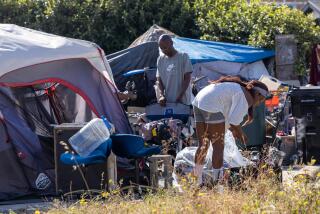Editorial: Out on the streets to count L.A.’s unhoused, volunteers learn far more than numbers can convey

- Share via
In a little more than a week, legions of volunteers will fan out across Los Angeles County to count people who are homeless. Over the course of three nights (Feb. 18-20) volunteers will walk or drive across the county, armed with maps of their assigned census tracts, a smartphone app for listing their tally, and instructions not to intrude upon the people who will be counted. No lifting the flaps of a tent you come across.
Volunteers arrive at about 150 deployment centers, where they get flashlights and maps and assemble into small groups for the annual point-in-time count, part of a nationwide effort that usually happens in January, but which Los Angeles delayed because of the wildfires. Already instructed on how to judge whether someone is probably homeless, volunteers note whether they counted an individual, a tent, a makeshift dwelling or a car. There is no guessing how many people might be in a tent. Those estimations are done later by researchers.
Some volunteers do speak to the homeless individuals they encounter. Last year, in Lincoln Heights, a group of three counters in one car came across a bus stop where a man and a woman with a fair amount of belongings stood. Were they people waiting for a bus? Were they homeless people with their belongings — perhaps also waiting for a bus? Someone in the car rolled down the window and explained that they were on the homeless count. The woman standing at the bus stop proclaimed, “I’m one of ‘em!”
This is an imperfect venture, of course. But there is no other undertaking that brings out roughly 5,000 volunteers over three nights not just to see homeless people but to feel the cold air and walk through the darkness. It’s uncomfortable and sometimes a little scary (although volunteers are always told to put their personal safety first and not enter any area that feels unsafe). And that’s a tiny glimpse of what L.A. nights are like for homeless people.
“You can’t help but wonder literally, ‘What is it like to live on the concrete?’” says Va Lecia Adams Kellum, the chief executive of the Los Angeles Homeless Services Authority, which organizes and runs the count. Adams Kellum will go out on each of the nights. She says LAHSA could never afford enough professional counters to replace volunteers. “And we lose community engagement if we do,” she adds. Part of the experience of being on the count, she said, is “knowing the magnitude of the humanitarian crisis.”
The agency tallies people living in shelters and other temporary housing as well. (Glendale, Pasadena and Burbank do their own separate counts.) The Los Angeles Homeless Services Authority also does a weeks-long demographic survey that is conducted by USC’s School of Social Work, which uses paid data collectors.
It’s already underway, and nearly 3,000 unhoused people had been interviewed as of late January.
There are other private-sector, professional studies of street homelessness. The Rand research organization has done long-term surveys of unhoused people. In a study of Venice, Skid Row and Hollywood — three communities with large homeless populations in Los Angeles — from late 2021 to late 2022, Rand researchers found increases in homelessness. In contrast, the county’s point-in-time count in January 2023 found decreases in those communities. Such variation only underscores the need for continued data collection and analysis, including the point-in-time count.
The tally a year ago registered a 2.2% drop in homelessness in the city of Los Angeles, and found the rate flat in the county overall. More dramatically, it showed a 10.4% drop in the number of homeless people living unsheltered (as opposed to in shelters and temporary housing) in the city and a 5.1% drop in the county.
Such data are important and valuable for policymakers. But some of the most profound lessons — what volunteers experience when they go out into the night — can’t be conveyed in numbers. You just have to be there.
More to Read
A cure for the common opinion
Get thought-provoking perspectives with our weekly newsletter.
You may occasionally receive promotional content from the Los Angeles Times.










